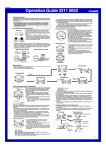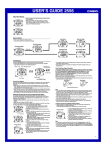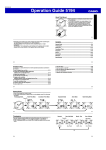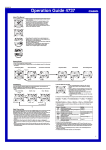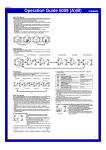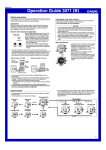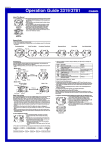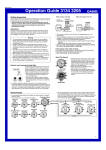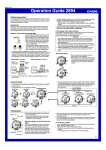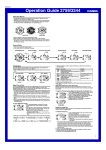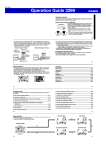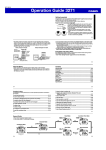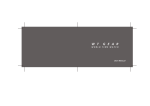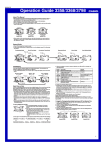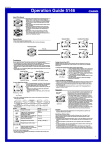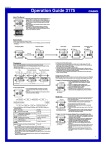Download User Manual - WeatherConnection
Transcript
MO0806-EA Operation Guide 3157 Getting Acquainted Congratulations upon your selection of this CASIO watch. To get the most out of your purchase, be sure to read this manual carefully. About This Manual (Light) Applications The built-in sensors of this watch measure direction and temperature. Measured values are then shown on the display. Such features make this watch useful when hiking, mountain climbing, or when engaging in other such outdoor activities. Warning! • The measurement functions built into this watch are not intended for use in taking measurements that require professional or industrial precision. Values produced by this watch should be considered as reasonably accurate representations only. • When engaging in mountain climbing or other activities in which losing your way can create a dangerous or life-threatening situation, always be sure to use a second compass to confirm direction readings. • Note that CASIO COMPUTER CO., LTD. assumes no responsibility for any damage or loss suffered by you or any third party arising through the use of this product or its malfunction. (Light) General Guide ▲ Digital Compass/ Thermometer Mode Stopwatch Mode World Time Mode ▲ • The illustration below shows which buttons you need to press to navigate between modes. • In any mode (except when a setting screen is on the display), press B to illuminate the display. • You can enter the Digital Compass/Thermometer Mode from the Timekeeping Mode by pressing D. To enter from another mode, first use C to enter the Timekeeping Mode, and then press D. • Depending on the model of your watch, display text appears either as dark figures on a light background or light figures on a dark background. All sample displays in this manual are shown using dark figures on a light background. • Button operations are indicated using the letters shown in the illustration. • Each section of this manual provides you with the information you need to perform operations in each mode. Further details and technical information can be found in the “Reference” section. Countdown Timer Mode Alarm Mode Timekeeping Mode Press C. ▲ ▲ ▲ ▲ ▲ Press D. Press C. Timekeeping Use the Timekeeping Mode to set and view the current time and date. Seconds Hour : Minutes Daylight Saving Time (summer time) advances the time setting by one hour from Standard Time. Remember that not all countries or even local areas use Daylight Saving Time. This watch is preset with a number of city codes, each of which represents the time zone where that city is located. When setting the time, it is important that you first select the correct city code for your Home City (the city where you normally use the watch). If your location is not included in the preset city codes, select the preset city code that is in the same time zone as your location. • Note that all of the times for the World Time Mode city codes are displayed in accordance with the time and date settings you configure in the Timekeeping Mode. To toggle the Timekeeping Mode time between DST and Standard Time 1. In the Timekeeping Mode, hold down A until the city On/Off status code starts to flash, which indicates the setting screen. 2. Press C once and the DST setting screen appears. 3. Press D to toggle between Daylight Saving Time (ON displayed) and Standard Time (OFF displayed). 4. Press A to exit the setting screen. • The DST indicator appears to indicate that Daylight Saving Time is turned on. To set the time and date 1. In the Timekeeping Mode, hold down A until the city code starts to flash, which indicates the setting screen. 2. Use D and B to select the city code you want. • Make sure you select your Home City code before changing any other setting. • For full information on city codes, see the “City Code Table”. 3. Press C to move the flashing in the sequence shown below to select the other settings. City Code Temperature Unit DST 12/24-Hour Format Day Month Second Year Hour Minute • The following steps explain how to configure timekeeping settings only. 4. When the timekeeping setting you want to change is flashing, use D and/or B to change it as described below. Screen Daylight Saving Time (DST) Setting Read This Before You Set the Time and Date! Day of week To do this: Change the city code Toggle between Daylight Saving Time ) and Standard Time ( ). ( Toggle between 12-hour (12H) and 24-hour (24H) timekeeping. Reset the seconds to 00 Do this: Use D (east) and B (west). Press D. Press D. Press D. Change the hour or minute Use D (+) and B (–). Change the year Use D (+) and B (–). Change the month or day 5. Press A to exit the setting screen. • For details about configuring temperature display settings, see “To specify the temperature display unit”. • See “Daylight Saving Time (DST) Setting” below for details about the DST setting. DST indicator Digital Compass/Thermometer You can take direction readings and temperature readings in the Digital Compass/ Thermometer Mode. Direction readings are taken by the watch’s built-in magnetic bearing sensor and displayed as one of 16 directions. A temperature sensor is used for temperature readings. • See “Digital Compass” for more information about the digital compass. • See “Thermometer” for more information about the thermometer. To enter and exit the Digital Compass/Thermometer Mode 1. While in the Timekeeping Mode, press D to enter the Digital Compass/Thermometer Mode. • The watch will start to take direction and temperature readings. After about two seconds, the direction that the 12 o’clock position of the watch is facing will be indicated and the current temperature reading will appear on the display. • Direction readings will be taken each second for about 10 seconds, and then stop automatically. During readings • Temperature readings will be taken every two About two seconds for about 10 seconds, and then stop seconds automatically. • To perform direction and temperature readings for another 10 seconds, press D again. 2. Press C to return to the Timekeeping Mode. • For information about using the digital compass, see “To take a direction reading”. • For information about using the thermometer, see “To take a temperature reading”. 12 o’clock position Current time ▲ Month – Day Thermometer The watch takes temperature readings automatically whenever you enter the Digital Compass/Thermometer Mode. In addition, you can take readings manually by performing the procedure below. • You can calibrate the temperature sensor if you think readings are wrong for some reason. • You can select either Celsius (°C) or Fahrenheit (°F) as the temperature unit. 1 Operation Guide 3157 To take a temperature reading In the Digital Compass/Thermometer Mode, press D. • This will display the temperature reading. • After the first reading, the watch will continue to take readings every two seconds for about 10 seconds. • To perform temperature readings for another 10 seconds, press D again. • The temperature is displayed in units of 0.1°C (or 0.2°F). • The display range of the thermometer screen is –10.0°C Temperature to 60.0°C (or 14.0°F to 140.0°F). The temperature display will show xxx if a temperature reading is outside the allowable range. Important! • Sudden temperature changes can affect pressure sensor readings. • Temperature measurements are affected by your body temperature (while you are wearing the watch), direct sunlight, and moisture. To achieve a more accurate temperature measurement, remove the watch from your wrist, place it in a well ventilated location out of direct sunlight, and wipe all moisture from the case. It takes approximately 20 to 30 minutes for the case of the watch to reach the actual surrounding temperature. Temperature Sensor Calibration The temperature sensor built into the watch is calibrated at the factory, and normally does not need any adjustment. However, if you feel that readings being produced by the watch are not correct for some reason, you can calibrate the temperature sensor to correct them. Important! • Incorrectly calibrating the temperature sensor can result in incorrect readings. Carefully read the following before doing anything. Compare the readings produced by the watch with those of another reliable and accurate thermometer. If adjustment is required, remove the watch from your wrist and wait for 20 or 30 minutes to give the temperature of the watch time to stabilize. To calibrate the temperature sensor 1. In the Digital Compass/Thermometer Mode, hold down A until the indicator at the 12 o’clock position starts to flash. 2. Press C twice and the current temperature calibration value will flash on the display. This is the temperature sensor calibration screen. 3. Use D (+) and B (–) to change the calibration value. • To return the temperature sensor to its factory default calibration (indicated by OFF on the display), press Current temperature D and B at the same time. calibration value 4. To exit the calibration screen, press A. ll lll To specify the temperature display unit 1. Enter the Timekeeping Mode. 2. Hold down A until the city code starts to flash, which llll l indicates the setting screen. 3. Press C nine times until the temperature display unit flashes on the display. • See step 3 under “To set the time and date” for information about how to scroll through setting screens. lll lll 4. Use D to switch between Celsius (°C) and Fahrenheit (°F). 5. Press A to exit the setting screen. Digital Compass The watch takes digital compass readings automatically whenever you enter the Digital Compass/Thermometer Mode. In addition, you can take readings manually by performing the procedure below. • See “Digital Compass Precautions” for important information about using the digital compass. • You can calibrate the direction bearing if you think readings are wrong for some reason. • For a digital compass practical example, see “Using the Digital Compass While Mountain Climbing or Hiking”. • The margin of error for the angle value and the direction indicator is ±11 degrees. If the indicated direction is northwest (NW) and 315 degrees, for example, the actual direction can be anywhere from 304 to 326 degrees. • Any ongoing direction measurement operation is paused temporarily while the watch is performing an alert operation (daily alarm, Hourly Time Signal, countdown timer alarm) or while illumination is turned on (by pressing B). The measurement operation resumes for its remaining duration after the operation that caused it to pause is finished. • The following table shows the meanings of each of the direction abbreviations that appear on the display. Direction N Meaning Direction North NNE E East ESE S South SSW W West WNW Meaning Direction Meaning Direction Meaning NorthEastNE Northeast ENE northeast northeast EastSouthSE Southeast SSE southeast southeast SouthWestSW Southwest WSW southwest southwest WestNorthNW Northwest NNW northwest northwest • See “Digital Compass Precautions” for other important information about taking direction readings. Digital Compass Precautions This watch features a built-in magnetic bearing sensor that detects terrestrial magnetism. This means that north indicated by this watch is magnetic north, which is somewhat different from true polar north. The magnetic north pole is located in northern Canada, while the magnetic south pole is in southern Australia. Note that the difference between magnetic north and true north as measured with all magnetic compasses tends to be greater as one gets closer to either of the magnetic poles. You also should remember that some maps indicate true north (instead of magnetic north), and so you should make allowances when using such maps with this watch. Location • Taking a direction reading when you are near a source of strong magnetism can cause large errors in readings. Because of this, you should avoid taking direction readings while in the vicinity of the following types of objects: permanent magnets (magnetic necklaces, etc.), concentrations of metal (metal doors, lockers, etc.), high tension wires, aerial wires, household appliances (TVs, personal computers, washing machines, freezers, etc.) • Accurate direction readings are impossible while in a train, boat, air plane, etc. • Accurate readings also are impossible indoors, especially inside ferro-concrete structures. This is because the metal framework of such structures picks up magnetism from appliances, etc. Storage • The precision of the bearing sensor may deteriorate if the watch becomes magnetized. Because of this, you should be sure to store the watch away from magnets or any other sources of strong magnetism, including: permanent magnets (magnetic necklaces, etc.) and household appliances (TVs, personal computers, washing machines, freezers, etc.) • Whenever you suspect that the watch may have become magnetized, perform one of the calibration procedures under “Calibrating the Bearing Sensor”. Calibrating the Bearing Sensor If you feel that direction readings being produced by the watch are not correct for some reason, you can calibrate the bearing sensor to correct them. You can use either of two methods to calibrate the bearing sensor: bearing sensor correction or magnetic declination correction. You also need to calibrate the bearing sensor if 100 days pass without calibration, and after you have the watch’s battery replaced. The message will appear on the display to remind you to calibrate. • Bearing Sensor Correction With bearing sensor correction, you rotate the watch in accordance with the movement of an on-screen indicator. Doing this will recalibrate the magnetic sensor of the watch with magnetic North for the area where you are located. • Magnetic Declination Correction With magnetic declination correction, you input a magnetic declination angle (difference between magnetic north and true north), which allows the watch to indicate true north. You can perform this procedure when the magnetic declination angle is indicated on the map you are using. Note that you can input the declination angle in degree units only, so you may need to round off the value specified on the map. If your map indicates the declination angle as 7.4°, you should input 7°. In the case of 7.6° input 8°, for 7.5° you can input 7° or 8°. SS D ▲ E One second ▲ E NE ENE S To calibrate the bearing sensor ▲ NN W SW WSW W To take a direction reading Direction indicator 1. While the watch is in the Digital Compass/Thermometer Mode, place it on a flat surface, or if you are wearing North 12 o’clock the watch, make sure that your wrist is horizontal (in pointer position relation to the horizon). 2. Point the 12 o’clock position of the watch in the direction you want to measure. 3. Press D to start a Digital Compass measurement operation. • After about two seconds, the direction that the 12 o’clock position of the watch is pointing appears on the display. Angle value (in degrees) • A pointer on the display indicates magnetic north. W NW NNW • After the first reading is obtained, the watch continues to 0° 270° WN N take direction readings automatically each second, for up to 10 seconds. • To perform direction readings for another 10 seconds, press D again. appearing on the display after a • The 90° 180° direction reading is complete indicates that bearing sensor calibration is required due to either of the reasons described below. When this happens, perform the procedure under “Calibrating the Bearing Sensor”. • It’s been 100 days since the last bearing sensor calibration. • The watch’s battery was replaced. • While the watch is taking compass readings, it displays a direction angle and a direction indicator, all of which change dynamically when the watch is moved. The direction angle, direction indicator and direction pointer all disappear from the display after the compass reading operation is complete. Use the direction indicators imprinted on the bezel to record the indicated direction. For details, see “Using the Digital Compass While Mountain Climbing or Hiking”. Note • Note that taking a measurement while the watch is not horizontal (in relation to the horizon) can result in large measurement error. Rotate the watch in accordance with the movement of the One flashing indicator. second 1. Remove the watch from your wrist, and position it so its back is parallel with the ground and the 12 o’clock position is pointed away from you. 2. In the Digital Compass/Thermometer Mode, hold down A until the indicator at the 12 o’clock position starts to flash. This is the calibration screen. 3. Press D. • The flashing indicator will move clockwise on the face of the watch with each passing second. 4. Each time the indicator moves, rotate the watch so the indicator remains pointed away from you. 5. After the flashing indicator completes two full trips around the display (and you rotate the watch twice), press C. • This completes calibration and exits the calibration screen. The message will appear on the display for about one second, and then a direction reading operation will be performed automatically. 2 ES E SE SSE Operation Guide 3157 World Time • If you want to cancel bearing sensor correction, press D in step 5 instead of C. This will return to the screen in step 2. From there you can press A to exit the calibration screen. • The indicator will go around the display up to four times, if you do not stop it by pressing C. After the fourth time, the watch will exit the calibration screen automatically. To perform magnetic declination correction 1. In the Digital Compass/Thermometer Mode, hold down Magnetic Magnetic A until the indicator at the 12 o’clock position starts to declination declination angle value angle direction flash. This is the calibration screen. 2. Press C. • The magnetic declination angle and magnetic declination angle direction will flash on the display. 3. Use D (+) and B (–) to change the magnetic declination angle and magnetic declination angle direction settings. • You can select a value within the range of 90° W to 90° E with these settings. • The following explains magnetic declination angle direction settings. 0 OFF: No magnetic declination correction performed. The magnetic declination angle with this setting is 0°. E: When magnetic north is to the east (east declination) W: When magnetic north is to the west (west declination) • You can turn off (0 OFF) magnetic declination correction (which effectively makes the magnetic declination angle: 0°) by pressing D and B at the same time. • The illustration, for example, shows the value you should input and the direction setting you should select when the map shows a magnetic declination of 1° West. 4. When the setting is the way you want, press A to exit the setting screen. Using the Digital Compass While Mountain Climbing or Hiking This section describes three real-life situations where you could use the watch’s builtin digital compass. • To set a map and find your current location Having an idea of your current location is important when mountain climbing or hiking. To do this, you need to “set the map”, which means to align the map so the directions indicated on it are aligned with the actual directions of your location. Basically what you are doing is aligning north on the map with north as indicated by the watch. • To find the bearing to an objective To set a map and find your current location 1. With the watch on your wrist, position it so the face is North indicated horizontal. on the map 2. In the Timekeeping Mode, press D to take a compass reading. • The reading will appear on the display after about two seconds. 3. Rotate the map without moving the watch so the northerly direction indicated on the map matches north as indicated by the watch. Current • If the watch is configured to indicate magnetic north, N location align the map’s magnetic north with the watch indication. If the watch has been configured with a declination to correct to true north, align the map’s true north with the watch indication. N •This will position the map in accordance with your current location. North indicated by 4. Determine your location as you check the geographic north pointer contours around you. To find the bearing to an objective 1. Take a compass reading and then set the map so its northerly indication is aligned with north as indicated by the watch, and determine your current location. N • See “To set a map and find your current location” for information about how to perform the above step. Objective 2. Set the map so the direction you want to travel on the map is pointed straight in front of you. Current 3. With the watch on your wrist, position it so the face is location horizontal. 4. In the Timekeeping Mode, press D to take a compass N 12 o’clock reading. position • The reading will appear on the display after about two seconds. 5. Still holding the map in front of you, turn your body until north as indicated by the watch and the northerly direction on the map are aligned. • This will position the map relative to your current location, so the bearing to your objective is straight ahead of you. Questions & Answers Question: What causes incorrect direction readings? Answer: • Nearby source of strong magnetism, such as a household appliance, a large steel bridge, a steel beam, overhead wires, etc., or an attempt to perform direction measurement on a train, boat, etc. Move away from large metal objects and try again. Note that digital compass operation cannot be performed inside a train, boat, etc. Timekeeping Mode time City code To view the time in another city In the World Time Mode, use D (east) to scroll through city codes (time zones). • For full information on city codes, see the “City Code Table”. Current time in the zone of the selected city code To toggle a city code time between Standard Time and Daylight Saving Time 1. In the World Time Mode, use D (east) to display the DST indicator city code (time zone) whose Standard Time/Daylight Saving Time setting you want to change. 2. Hold down A to toggle between Daylight Saving Time (DST indicator displayed) and Standard Time (DST indicator not displayed). • The DST indicator appears on the display whenever you display a city code for which Daylight Saving Time is turned on. • Note that the DST/Standard Time setting affects only the currently displayed city code. Other city codes are not affected. Stopwatch Current time Minutes Seconds 1/100 second The stopwatch lets you measure elapsed time, split times, and two finishes. • The display range of the stopwatch is 59 minutes, 59.99 seconds. • The stopwatch continues to run, restarting from zero after it reaches its limit, until you stop it. • The stopwatch measurement operation continues even if you exit the Stopwatch Mode. • Exiting the Stopwatch Mode while a split time is frozen on the display clears the split time and returns to elapsed time measurement. • All of the operations in this section are performed in the Stopwatch Mode, which you enter by pressing C. To measure times with the stopwatch Elapsed Time D JD Start Stop JD Re-start Split Time D JA JA Start Split Split release (SPL displayed) Two Finishes D JA JD Start Split Stop First runner Second runner finishes. finishes. Display time of first runner. JD JA Stop Clear JD JA Stop Clear JA Split release Display time of second runner. JA Clear Countdown Timer You can set the countdown timer within a range of one minute to 24 hours. An alarm sounds when the countdown reaches zero. • You also can select auto-repeat, which automatically restarts the countdown from the original value you set whenever zero is reached. • All of the operations in this section are performed in the Countdown Timer Mode, which you enter by pressing C. Current time Hours Minutes Seconds To configure countdown start time and auto-repeat settings 1. While the countdown start time is on the display in the Countdown Timer Mode, hold down A until the hour setting of the countdown start time starts to flash, which indicates the setting screen. • If the countdown start time is not displayed, use the procedure under “To use the countdown timer” to display it. 2. Press C to move the flashing in the sequence shown below, and select the setting you want to change. Start Time (Hours) Question: What causes different direction readings to produce different results at the same location ? Answer: Magnetism generated by nearby high-tension wires is interfering with detection of terrestrial magnetism. Move away from the high-tension wires and try again. Question: Why am I having problems taking direction readings indoors ? Answer: A TV, personal computer, speakers, or some other object is interfering with terrestrial magnetism readings. Move away from the object causing the interference or take the direction reading outdoors. Indoor direction readings are particularly difficult inside ferro-concrete structures. Remember that you will not be able to take direction readings inside of trains, airplanes, etc. World Time displays the current time in 48 cities (29 time zones) around the world. • If the current time shown for a city is wrong, check your Home City time settings and make the necessary changes. • All of the operations in this section are performed in the World Time Mode, which you enter by pressing C. Auto-repeat on indicator Start Time (Minutes) Auto-Repeat On/Off 3. Perform the following operations, depending on which setting is currently selected on the display. • While the start time setting is flashing, use D (+) and B (–) to change it. • Set 0:00 to specify 24 hours. • While the auto-repeat on/off setting (0N or 0FF) is flashing on the display, press D to toggle auto-repeat on (0N) and off (0FF). 4. Press A to exit the setting screen. • The auto-repeat on indicator ( ) is displayed on the Countdown Timer Mode screen while this function is turned on. • Frequent use of auto-repeat and the alarm can run down battery power. 3 Operation Guide 3157 Reference To use the countdown timer Press D while in the Countdown Timer Mode to start the countdown timer. • When the end of the countdown is reached and auto-repeat is turned off, the alarm sounds for 10 seconds or until you stop it by pressing any button. The countdown time is automatically reset to its starting value after the alarm stops. • When auto-repeat is turned on, the countdown will restart automatically without pausing when it reaches zero. The alarm sounds to signal when the countdown reaches zero. • The countdown timer measurement operation continues even if you exit the Countdown Timer Mode. • To stop a countdown operation completely, first pause it (by pressing D), and then press A. This returns the countdown time to its starting value. Alarms Current time Alarm number Alarm time (Hour : Minutes) The Alarm Mode gives you a choice of four one-time alarms and one snooze alarm. Also use the Alarm Mode to turn the hourly time signal (SIG) on and off. • There are five alarms numbered AL1through AL4, and SNZ. You can configure SNZ as a snooze alarm only. Alarms AL1through AL4 can be used as onetime alarms only. • When you enter the Alarm Mode, the data you were viewing when you last exited the mode appears first. • All of the operations in this section are performed in the Alarm Mode, which you enter by pressing C. Auto Return Feature • The watch will return to the Timekeeping Mode automatically if you do not perform any operation for about two or three minutes while in the Digital Compass/ Thermometer Mode or Alarm Mode. • If you leave a screen with flashing digits on the display without performing any operation for two or three minutes, the watch saves any settings you have made up to that point and exits the setting screen automatically. Button Operation Tone The button operation tone sounds any time you press one of the watch’s buttons. You can turn the button operation tone on or off as desired. • Even if you turn off the button operation tone, the alarm, hourly time signal, and Countdown Timer Mode alarm all operate normally. To turn the button operation tone on and off In any mode (except when a setting screen is on the Mute indicator display), hold down C to toggle the button operation tone on ( not displayed) and off ( displayed). • Since the C button also is the mode change button, holding it down to turn the button operation on or off also causes the watch’s current mode to change. • The indicator is displayed in all modes when the button operation tone is turned off. Data and Setting Scrolling To set an alarm time 1. In the Alarm Mode, use D to scroll through the alarm screens until the one whose time you want to set is displayed. AL1 Alarm on indicator This section contains more detailed and technical information about watch operation. It also contains important precautions and notes about the various features and functions of this watch. SIG D AL2 AL3 SNZ AL4 Sensor Error and Low Battery Displays Subjecting the watch to strong impact can damage the sensor or cause internal connection problems. These conditions will cause (error) to appear on the display, indicating that sensor operation is disabled. Sensor operation also is disabled whenever (battery) is on the display, which indicates insufficient battery power or voltage due to a low battery or a cold environment. • If an error occurs or the battery goes low during sensor operation, or will appear in the upper right of the display for about 10 seconds, and then change to ---. ▲ 2. Hold down A until the hour setting of the alarm time start to flash, which indicates the setting screen. • This automatically turns on the alarm. 3. Press C to move the flashing between the hour and minute settings. 4. While a setting is flashing, use D (+) and B (–) to change it. • When setting the alarm time using the 12-hour format, take care to set the time correctly as a.m. (no indicator) or p.m. (P indicator). 5. Press A to exit the setting screen. The B and D buttons are used in various modes and setting screens to scroll through data on the display. In most cases, holding down these buttons during a scroll operation scrolls through the data at high speed. Alarm Operation The alarm tone sounds at the preset time for 10 seconds, regardless of the mode the watch is in. In the case of the snooze alarm, the alarm operation is performed a total of seven times, every five minutes, until you turn the alarm off. • Alarm and hourly time signal operations are performed in accordance with the Timekeeping Mode time. • To stop the alarm tone after it starts to sound, press any button. • Performing any one of the following operations during a 5-minute interval between snooze alarms cancels the current snooze alarm operation. Displaying the Timekeeping Mode setting screen Displaying the SNZ setting screen To test the alarm In the Alarm Mode, hold down D to sound the alarm. To turn an alarm and the hourly time signal on and off 1. In the Alarm Mode, use D to select an alarm or the hourly time signal. 2. When the alarm or the hourly time signal you want is selected, press A to toggle it on and off. : Indicates alarm is on. : Indicates snooze alarm is on. : Indicates Hourly Time Signal is on. • The alarm on indicator ( ), snooze on indicator ( ), and hourly time signal on indicator ( ) are displayed on all modes. • If any alarm is on, the alarm on indicator is shown on the display in all modes. Illumination This watch has an EL (electro-luminescent) panel that causes the entire display to glow for easy reading in the dark. • The electro-luminescent panel that provides illumination loses power after very long use. • Illumination may be hard to see when viewed under direct sunlight. • The watch may emit an audible sound whenever the display is illuminated. This is due to vibration of the EL panel used for illumination, and does not indicate malfunction. • Illumination turns off automatically whenever an alarm sounds. • Frequent use of illumination runs down the battery. • If an error occurs or the battery goes low during bearing sensor correction, or will appear in the upper right of the display for about one second, and then the calibration screen will appear. Try performing calibration again. • If an error occurs or the battery goes low during temperature sensor calibration, or will appear on the display for about one second. Next, xxx will flash for the temperature value in the center of the display. This indicates that temperature sensor calibration is not possible. Press A to exit the calibration screen, and then try performing temperature sensor calibration again. • If the message appears frequently, it could mean the sensor is malfunctioning. Whenever you have a sensor malfunction, be sure to take the watch to your original dealer or nearest authorized CASIO distributor as soon as possible. Timekeeping • Resetting the seconds to 00 while the current count is in the range of 30 to 59 causes the minutes to be increased by 1. In the range of 00 to 29, the seconds are reset to 00 without changing the minutes. • With the 12-hour format, the P (PM) indicator appears on the display for times in the range of noon to 11:59 p.m. and no indicator appears for times in the range of midnight to 11:59 a.m. • With the 24-hour format, times are displayed in the range of 0:00 to 23:59, without any indicator. • The year can be set in the range of 2000 to 2099. • The watch’s built-in full automatic calendar makes allowances for different month lengths and leap years. Once you set the date, there should be no reason to change it except after you have the watch’s battery replaced. • The times for the Timekeeping Mode and all the city codes of the World Time Mode are calculated in accordance with each city’s UTC offset. • The UTC offset is a value that indicates the time difference between a reference point in Greenwich, England and the time zone where a city is located. • The letters UTC is the abbreviation for Coordinated Universal Time, which is the world-wide scientific standard of timekeeping. It is based upon carefully maintained atomic (cesium) clocks that keep time accurately to within microseconds. Leap seconds are added or subtracted as necessary to keep UTC in sync with the Earth’s rotation. To turn on illumination In any mode (except when a setting screen is on the display), press B to illuminate the display for about one second. 4 Operation Guide 3157 City Code Table City Code City PPG HNL ANC YVR LAX YEA DEN MEX CHI MIA YTO NYC SCL YHZ YYT RIO RAI LIS LON MAD PAR ROM BER STO ATH CAI JRS MOW JED THR DXB KBL KHI DEL DAC RGN BKK SIN HKG BJS TPE SEL TYO ADL GUM SYD NOU WLG Pago Pago Honolulu Anchorage Vancouver Los Angeles Edmonton Denver Mexico City Chicago Miami Toronto New York Santiago Halifax St. Johns Rio De Janeiro Praia Lisbon London Madrid Paris Rome Berlin Stockholm Athens Cairo Jerusalem Moscow Jeddah Tehran Dubai Kabul Karachi Delhi Dhaka Yangon Bangkok Singapore Hong Kong Beijing Taipei Seoul Tokyo Adelaide Guam Sydney Noumea Wellington UTC Offset –11.0 –10.0 –09.0 –08.0 –07.0 –06.0 –05.0 –04.0 –03.5 –03.0 –01.0 +00.0 +01.0 +02.0 +03.0 +03.5 +04.0 +04.5 +05.0 +05.5 +06.0 +06.5 +07.0 +08.0 +09.0 +09.5 +10.0 +11.0 +12.0 • Based on data as of March 2008. • UTC offsets and the use of summer time are subject to change in the country where they are used. 5





